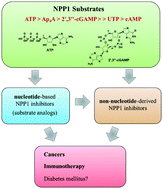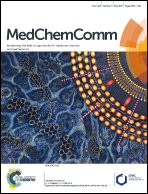Nucleotide pyrophosphatase/phosphodiesterase 1 (NPP1) and its inhibitors†
Abstract
Ecto-nucleotide pyrophosphatase/phosphodiesterase 1 (NPP1, EC 3.1.4.1) is a metalloenzyme that belongs to the NPP family, which comprises seven subtypes (NPP1-7). NPP1 hydrolyzes a wide range of phosphodiester bonds, e.g. in nucleoside triphosphates, (cyclic) dinucleotides, and nucleotide sugars yielding nucleoside 5′-monophosphates as products. Its main substrate is ATP which is cleaved to AMP and diphosphate. The enzyme is involved in various biological processes including bone mineralization, soft-tissue calcification, insulin receptor signalling, cancer cell proliferation and immune modulation. Therefore, NPP1 inhibitors have potential as novel drugs, e.g. for (immuno)oncology. In the last two decades several inhibitors of NPP1 derived from nucleotide- or non-nucleotide scaffolds have been developed. The most potent and selective NPP1-inhibitory substrate analog is adenosine 5′-α,β-methylene-γ-thiotriphosphate (Ki = 20 nM vs. p-Nph-5′-TMP, human membrane-bound NPP1). Non-nucleotide-derived NPP1 inhibitors comprise polysulfonates, polysaccharides, polyoxometalates and small heterocyclic compounds. The polyoxometalate [TiW11CoO40]8− (PSB-POM141) is the most potent and selective NPP1 inhibitor described to date (Ki = 1.46 nM vs. ATP, human soluble NPP1); it displays an allosteric mechanism of inhibition and represents a useful pharmacological tool for evaluating the potential of NPP1 as a novel drug target.



 Please wait while we load your content...
Please wait while we load your content...